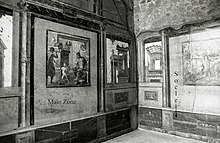
Back Calcil AN وزرة (هندسية معمارية) Arabic Цокаль Byelorussian Цокаль BE-X-OLD Цокъл Bulgarian Soklo Esperanto Zócalo (arquitectura) Spanish Sokkel Estonian پاسنگ ستون Persian Sokkeli Finnish


In architecture, a socle is a short plinth used to support a pedestal, sculpture, or column. In English, the term tends to be most used for the bases for rather small sculptures, with plinth or pedestal preferred for larger examples.[1] This is not the case in French.
In the field of archaeology this term refers to a wall base, frequently of stone, that supports the upper part of the wall, which is made of a different material – frequently mudbrick. This was a typical building practice in ancient Greece, resulting in the frequent preservation of the plans of ancient buildings only in their stone-built lower walls, as at the city of Olynthos.[2] A very early example is the two-storey fortified House of the Tiles at Lerna in the Peloponnese, built of mud-brick over a stone socle, with much use of wood, and clay for the floors and as stucco for the walls. This dates to the Early Helladic II, of four thousand years ago.

In Pompeian interior painting styles, the socle is the lowest zone of wall painting in all four style periods.[3]
- ^ As defined in Merriam Webster Online Dictionary.
- ^ Maher, Matthew P, The Fortifications of Arkadian City States in the Classical and Hellenistic Periods, p. 36, 2017, Oxford University Press, ISBN 0191090204, 9780191090202, google books
- ^ Clarke, John R., The Houses of Roman Italy, 100 B.C.-A.D. 250, Ritual, Space, and Decoration, University of California Press, 1991.